In the world of fine fragrance, the sensory journey begins long before the first spritz. The mere sight of a perfume bottle can evoke emotion, hint at a scent’s personality, and convey a brand’s values. At the core of this visual and tactile experience lies a material that is often taken for granted—glass. While packaging design, color palettes, and logos may capture immediate attention, the type of glass used in perfume packaging plays a crucial yet underappreciated role in the fragrance experience.
Glass, in its many forms, is more than a simple container. It is a protector of delicate aromatic compounds, a silent communicator of luxury or earthiness, and increasingly, a symbol of a brand’s commitment to sustainability. From the laboratory-grade precision of borosilicate to the high clarity of flint glass, and from colored UV-protective materials to the raw character of recycled glass, every glass type has a story—and a function.
This blog explores the nuanced world of glass materials in perfume packaging. We’ll examine how the chemical makeup, clarity, weight, and finish of different glass types affect everything from fragrance longevity to branding and market positioning. Whether you’re a fragrance house seeking a distinct identity, a packaging designer looking to innovate, or a consumer curious about what’s behind your favorite bottle, understanding the significance of glass type is key.
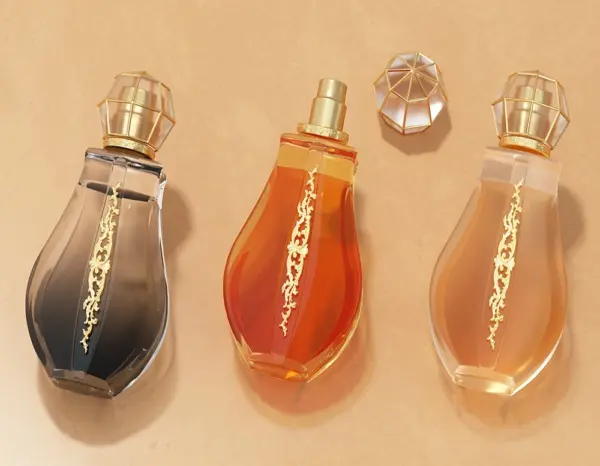
The Functional Role of Glass in Fragrance Preservation
Perfume is much more than a simple liquid; it is a carefully balanced mixture of volatile aromatic compounds, suspended in a base of alcohol or oil. These ingredients are inherently sensitive—they will readily react or degrade when exposed to certain external conditions. Factors such as heat, light (especially UV radiation), and air can quickly turn a premium scent into a faded or altered version of itself. Therefore, preserving the authentic character of a fragrance from the moment it is bottled to the final spritz relies heavily on the packaging material—specifically, glass.
Why Glass is Superior for Preservation
Unlike alternatives such as plastic or metal, glass possesses a unique set of properties that make it outstanding for fragrance preservation:
- Non-porous Structure: Glass is impermeable at the molecular level. This means that air, water vapor, and volatile fragrance compounds cannot pass through it in either direction, ensuring that the perfume’s delicate balance remains unchanged.
- Chemical Inertness: Glass does not react or interact with the substances housed within it, regardless of the formulation’s acidity or alcohol content. As a result, there is no risk of unwanted chemical reactions, contamination, or flavor/scent alteration—which can occur with certain plastics or metals.
- Barrier Against Leaching: Whereas some plastics can leach chemicals into the perfume, glass acts as a stable, neutral barrier, securing the purity and regulatory compliance of the product.
Physical Properties: Shielding Against Environmental Threats
The preservation power of glass is enhanced by its physical characteristics:
Thickness: Thicker or denser glass acts as a better buffer against sudden temperature changes, absorbing and slowing heat transfer. This stability helps prevent the breakdown of thermally sensitive fragrance components.
Clarity and Color: While crystal-clear glass showcases the perfumer’s creation, it also exposes the contents to potentially harmful light. Colored glass—such as amber, cobalt, or deep green—provides crucial UV protection, helping to shield the fragrance from photochemical reactions that can fade or alter top and heart notes. This is particularly important for blends rich in natural essential oils or citrus accords, which are more susceptible to light-induced degradation.
Maintaining the Perfumer’s Vision
Ultimately, the technical role of glass goes well beyond aesthetics. By acting as a robust, inert, and protective enclosure, glass ensures that the sensory experience envisioned by the perfumer is delivered accurately to the consumer. It prevents oxidation, preserves aromatic integrity, and extends shelf life—guaranteeing that what the nose detects at the first spray is precisely what was intended during creation.
In essence, glass does more than just look beautiful on a vanity: it is the first and most vital guardian of fragrance authenticity, quality, and longevity.
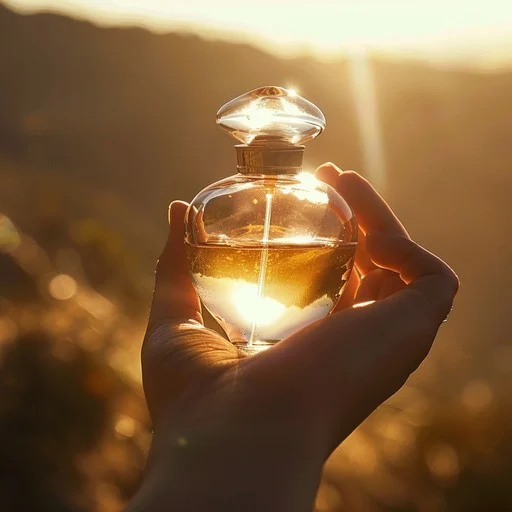
Overview of Glass Types Used in Perfume Bottles
Not all glass is created equal, especially in the perfume industry. The appearance, feel, performance, and environmental footprint of a perfume bottle depend heavily on the type of glass used in its manufacturing. There are five primary categories of glass commonly used in fragrance packaging:
Borosilicate Glass: Known for its thermal and chemical stability, making it ideal for high-end and natural perfumes.
Soda-Lime Glass: The most widely used due to its cost-effectiveness and versatility.
High Flint Glass: Appreciated for its exceptional clarity and brilliance, mimicking the appearance of crystal.
Colored Glass: Offers both UV protection and a way to visually differentiate products.
Recycled Glass: Aligns with the growing demand for eco-conscious and authentic packaging.
Each type has its strengths and considerations. The sections that follow will explore these in greater detail to help perfume professionals make informed material choices.
Deep Dive into Each Glass Type
Borosilicate Glass: The Chemist’s Choice
Borosilicate glass is prized in scientific and industrial settings for its resilience under extreme conditions. It is composed of silica and boron trioxide, which together provide exceptional thermal and chemical resistance. This durability makes borosilicate an excellent choice for perfume formulations that are particularly sensitive or that rely on high concentrations of essential oils.
Natural and organic fragrance brands often turn to borosilicate glass for packaging because it ensures that no chemical interaction occurs between the container and the formulation. This is critical for products that avoid synthetic preservatives and stabilizers. In such cases, even minor leaching from conventional glass types could compromise the scent’s integrity.
The aesthetic of borosilicate glass also appeals to brands with a minimalist, clinical, or apothecary-inspired visual identity. Its high clarity and clean lines suggest purity and precision, qualities that resonate with consumers seeking wellness-oriented or artisanal fragrances.
However, borosilicate glass tends to be more expensive to manufacture and less flexible in terms of shape and decoration compared to soda-lime. This can limit design options for brands looking to stand out on shelves. Despite these limitations, its technical superiority makes it the glass of choice for high-performance, high-integrity fragrance packaging.
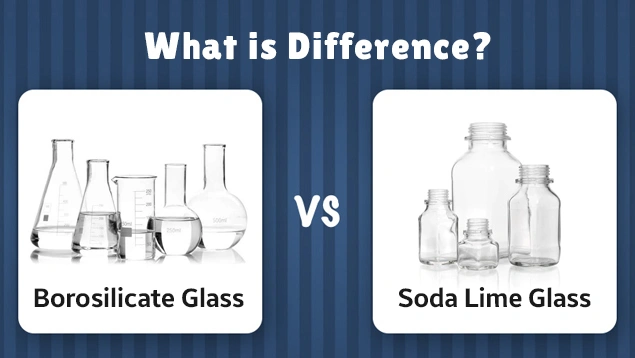
Soda-Lime Glass: The Industry Standard
Soda-lime glass is the workhorse of the perfume packaging world. Composed mainly of silica, soda ash, and lime, it accounts for approximately 90% of all glass produced globally. It’s the default choice for mass-market and mid-tier perfumes due to its affordability and adaptability.
Soda-lime glass can be molded into an infinite variety of shapes and can be easily colored, coated, or decorated using screen printing, hot stamping, and lacquering. This versatility allows perfume brands to create unique, brand-defining packaging without the high costs associated with specialty glass.
Despite its widespread use, soda-lime glass does have its limitations. It is more chemically reactive than borosilicate and may not be ideal for highly sensitive or natural formulas. Its thermal resistance is also lower, which can be a concern during storage or shipping in fluctuating temperatures.
To mitigate these drawbacks, manufacturers often apply protective coatings or inner linings to soda-lime bottles, enhancing their resistance without compromising cost-efficiency. In many cases, this hybrid approach offers the best of both worlds: cost-effective manufacturing with improved performance.
Overall, soda-lime glass remains a staple in perfume packaging thanks to its balance of function, form, and flexibility. It’s the perfect entry point for new brands and a reliable standard for established lines.
High Flint Glass: Clarity and Prestige
For brands that aim to captivate customers through visual brilliance, high flint glass is the material of choice. This glass type contains a higher content of lead oxide or, in modern formulations, barium and zinc oxides. These additives increase the refractive index of the glass, resulting in exceptional clarity, brilliance, and weight.
High flint glass resembles fine crystal and is commonly used for luxury and prestige fragrances. Its optical clarity allows perfume colors to shine through vividly, while its weight contributes to the tactile sense of quality. A heavy, clear perfume bottle conveys permanence, sophistication, and premium value—key traits in a market where first impressions matter.
The production of traditional lead crystal is becoming less common due to health and environmental concerns. Modern high flint glasses now substitute lead with safer alternatives while preserving visual brilliance. These newer formulations are more sustainable and compliant with regulations, particularly in the EU and U.S. markets.
That said, high flint glass is more expensive and energy-intensive to produce than soda-lime. It’s also more fragile, which can pose logistical challenges during transport. Nevertheless, for flagship products and designer lines, the aesthetic payoff is often worth the trade-off.
In the luxury perfume segment, high flint glass serves as both a functional container and an emotional trigger. It transforms the bottle into a collectible object—one that consumers proudly display, gift, or even repurpose.
Colored Glass: Function Meets Aesthetic
Color in perfume bottles is not merely decorative—it can be highly functional. Colored glass, especially in amber, cobalt blue, green, or black, provides protection from ultraviolet (UV) light, which is known to degrade essential oils and aromatic compounds. For perfumes rich in naturals or oils, UV protection can significantly extend shelf life.
Amber and green glasses have long been used in pharmaceutical and apothecary packaging for this very reason. When used in perfume packaging, they convey authenticity and a sense of herbal purity. In contrast, deep blue or matte black bottles suggest mystery, marine themes, or masculinity, depending on the brand narrative.
There are two primary methods for achieving colored glass: in-mass coloring and surface coating. In-mass coloring involves adding metal oxides to the molten glass, ensuring the color is uniform throughout. This method is more durable but also more expensive. Surface coatings, on the other hand, are applied post-production and can include lacquers, enamels, or metallized films. While these offer greater flexibility and visual effects, they may chip or fade over time.
Colored glass also allows for interesting combinations of texture and tone. Frosted finishes, gradients, and transparent tints can reinforce the sensory messaging of a fragrance. For instance, a translucent pink bottle might evoke softness and femininity, while a smoky gray bottle suggests sophistication and complexity.
Ultimately, colored glass merges aesthetic storytelling with practical preservation. It’s a smart choice for brands that want their packaging to work harder—functionally and emotionally.
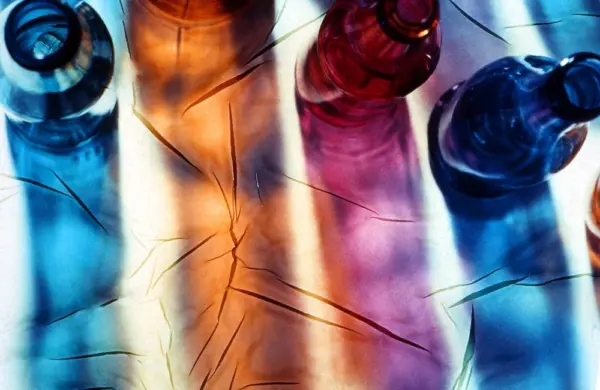
Recycled Glass: Raw, Real, and Responsible
Sustainability is no longer a niche concern—it’s a global imperative. In the perfume industry, this shift is prompting brands to reconsider the lifecycle of their packaging. Recycled glass, often referred to as cullet, is gaining traction as a sustainable solution that also adds character and authenticity.
Recycled glass is made by melting down post-consumer or post-industrial glass and remolding it into new containers. This process uses less energy than producing new glass from raw materials and helps reduce landfill waste. Depending on the manufacturing process, bottles made from recycled glass may appear slightly irregular in color, texture, or thickness—traits that some brands embrace as signs of honesty and raw beauty.
For eco-conscious fragrance houses, recycled glass aligns perfectly with brand values. It suggests transparency, ethical sourcing, and environmental stewardship. Some brands even highlight these variations as part of their marketing story, positioning the imperfections as symbols of authenticity.
However, recycled glass presents some challenges. Its chemical composition may vary, making quality control more complex. There’s also a trade-off between recycled content and clarity; high-purity recycled glass is harder to achieve, especially when using mixed-color cullet.
Innovations in recycling technology are addressing many of these concerns. Today, it’s possible to produce high-clarity bottles with up to 70% recycled content. Some manufacturers even offer closed-loop systems where returned bottles are sanitized, crushed, and reused within the same production cycle.
In a market where consumers increasingly scrutinize the environmental footprint of their purchases, recycled glass offers a compelling blend of ethics and aesthetics.
Matching Glass to Brand Strategy: Expressing Identity Through Packaging Choices
Choosing the right type of glass for a fragrance bottle is much more than a technical matter—it is a deeply strategic branding decision that can define how consumers perceive, interact with, and remember your product. Glass, in this context, is both canvas and communicator: it silently speaks volumes about quality, intention, and values without a single word printed on its surface. For perfume and cosmetic brands, aligning glass selection with overall brand strategy is essential for standing out in a crowded marketplace and forming authentic consumer connections.
Aligning Glass Selection with Brand Positioning
Value and Affordability:
For emerging brands or those targeting the mass market—such as startups launching affordable body mists or daily fragrances—soda-lime glass is the typical choice. It is cost-effective, easy to manufacture in a variety of shapes and sizes, and supports basic decoration. Choosing soda-lime allows for budget control without compromising on safety or broad appeal, positioning these fragrances as accessible and functional.
Purity and Naturalness:
Boutique brands, especially those marketing natural, organic, or essential oil-rich fragrances, may gravitate towards borosilicate glass. Its superior chemical inertness and laboratory associations reinforce messages of purity and transparency. By using borosilicate, these brands can credibly claim that nothing will interfere with their precious formulations—appealing to ingredient-conscious, discerning buyers looking for authenticity and clean beauty.
Prestige and Luxury:
Designer houses and high-end niche brands often invest in high flint glass or crystal-like compositions. The brilliance, weight, and tactile satisfaction of high flint signal luxury before the bottle is even opened. In markets where prestige matters—such as mature European and Middle Eastern fragrance consumers—this choice becomes a non-negotiable element of the overall luxury experience.
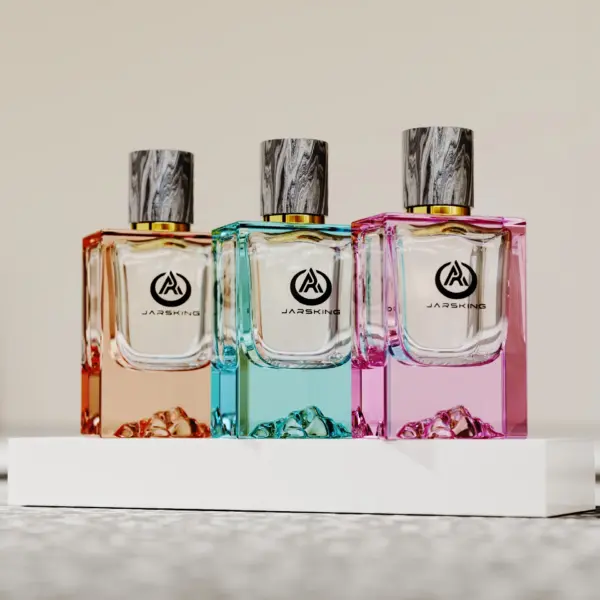
Glass as a Storytelling Device
Glass can reinforce a product’s narrative through color, clarity, finish, and even imperfections:
- Color as Emotion and Metaphor:
Amber glass might be chosen for a desert-inspired fragrance, conjuring warmth, light, and sun protection while safeguarding sensitive oils from UV damage.
Pale blue flint glass evokes the freshness of ocean breezes or expansive skies, making it perfect for aquatic or marine scents.
Green, smoky, or pastel tints can allude to fresh botanicals, nostalgia, or modern minimalism, layering visual cues that prime the customer’s imagination.
- Textural and Aesthetic Authenticity:
For sustainability-focused or artisanal brands, embracing recycled glass—with its minute color variations, bubbles, or tiny inconsistencies—not only reduces environmental impact but visibly signals a commitment to authenticity and craftsmanship. This kind of “imperfect beauty” is especially powerful for eco-luxury narratives. - Finish and Sensory Experience:
Frosted or matte finishes can suggest serenity or understated elegance; heavy glass bases can lend a sense of permanence and quality; ultra-clear glass supports a narrative of purity or modernity.
Regional Market Influences
Europe:
Markets such as France and Germany increasingly value sustainability and compliance with strict environmental regulations. Recycled glass and lead-free high flint glass are in high demand. There is also a cultural appreciation for both tradition (luxury cues) and visible responsibility.
Asia:
Asian consumers often prioritize visual finish, decorative complexity, and bottle weight as markers of value. Intricate lacquering, colored gradients, faceting, and unusual shapes are popular, with glass selection tailored for maximum shelf impact.
United States:
American buyers respond strongly to innovation and practical sustainability—think refillable bottles, modular components, or smart glass features. Recycled content is a plus, but so is creative use of form and function that stands out on shelves and social media.
Glass as a Silent Messenger
Above all, the glass you choose sets the stage for every interaction with your perfume, influencing:
Perceived value: Heavy or sparkling glass suggests luxury, while lighter, simpler bottles signal accessibility or eco-conscious minimalism.
Brand ethos: Is your brand forward-thinking and green? Minimalist and direct? Romantic and traditional? The right glass instantly communicates these messages and supports the rest of your visual identity.
Target demographic alignment: From young, eco-informed shoppers to luxury connoisseurs, the glass type helps attract and reassure your ideal customer.

Future Trends in Perfume Glass Packaging
The landscape of perfume glass packaging is undergoing a transformative shift, propelled by advances in technology, growing environmental awareness, and changing consumer values. Brands, manufacturers, and designers are no longer content with the status quo; they are embracing innovation to redefine not only what a perfume bottle looks like, but also how it functions, how it is made, and the role it plays in a circular economy. Here’s an in-depth look at the most influential trends shaping the future of perfume glass packaging:
Refillable and Reusable Bottle Designs
One of the most significant shifts is the surge in refillable perfume bottles. These are engineered with durable glass compositions—often premium flint or borosilicate—paired with robust metal pump systems that withstand repeated use. The core benefits include:
Waste Reduction: Consumers keep and reuse the beautiful bottle, resulting in less landfill and lower demand for single-use packaging.
Brand Loyalty: The investment in a refill system fosters ongoing engagement, increasing customer lifetime value by encouraging repeat purchases of fragrance refills.
Longevity: High-quality glass ensures the vessel remains pristine and functional through many life cycles.
Luxury brands and niche perfumers alike are investing in modular designs and sleek refill stations, recognizing both environmental and business opportunity in this ‘reuse revolution.’
Green Manufacturing and Material Innovation
The environmental costs of traditional glassmaking—high temperatures, significant energy consumption, and associated carbon emissions—are driving change. New green initiatives include:
Low-Temperature Melting: Advances in glass chemistry enable some compositions to melt at lower temperatures, reducing fuel use and emissions.
Electric Furnaces: Shifting from gas-fired to electric or hybrid furnaces (often powered by renewables) slashes the carbon footprint of the manufacturing process.
Carbon Capture: Some glass factories are piloting systems that trap CO₂ released during firing, curbing emissions and moving toward net-zero operations.
Emerging alongside these manufacturing improvements are hybrid glass materials that blend traditional glass with biodegradable biopolymers. This innovation aims to maintain the optical clarity and protection of glass, while introducing compostable or more easily recyclable components—a potential game changer for brands anxious to reach more ambitious sustainability goals.
Embracing Craft and Artisanal Glass
Another rising trend is consumer appetite for the unique artistry of handmade, limited-edition bottles. These may feature:
Hand-blown forms: Each piece is slightly different, celebrating imperfection and craftsmanship.
Engraving or hand painting: Personalized touches elevate the bottle from mere packaging to collectible art.
Unusual colors and finishes: Small-batch artisans can experiment with pigments, inclusions, and surface treatments not viable in mass production.
In a world of mass-produced sameness, such artisanal packaging stands apart—appealing to collectors, gifting markets, and luxury buyers who seek exclusivity as much as fragrance.
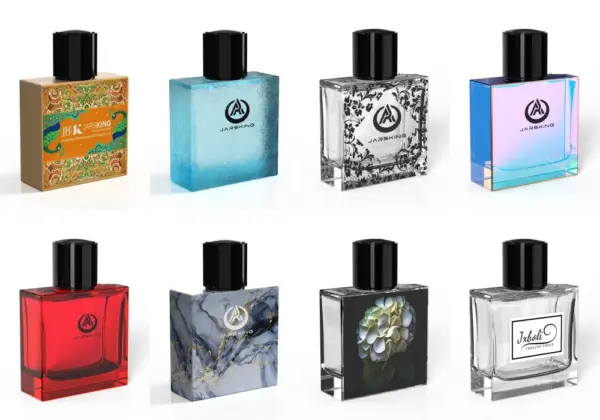
Balancing Tradition with Innovation
As these innovations unfold, brands are tasked with balancing the timeless beauty and prestige of glass with the demands of a changing world:
Aesthetic Resonance: Expect to see bottles that maintain classic lines but incorporate recycled glass, bold new color stories, or decorative details enabled by advanced manufacturing.
Function First: Technical superiority—whether in preservation, durability, or sustainability—remains a non-negotiable, regardless of how futuristic the design becomes.
Storytelling: As consumers become more invested in the provenance and afterlife of what they purchase, glass packaging will be used as a canvas for communicating environmental commitment, heritage, and artistic vision.
Conclusion
To the discerning consumer, the bottle is an invitation—a silent promise of what awaits. Borosilicate glass hints at purity and meticulous craftsmanship; soda-lime suggests accessibility and broad appeal; high flint glass bespeaks opulence and keepsake value. Colored bottles both protect and allure, while recycled glass sends a message of care for the planet and authenticity.
Every decision—from the weight in your hand, the hue that catches your eye, to the subtle imperfections or the perfect clarity—is a strategic expression of brand and story. The glass bottle is the first sensor—a tactile, visual, and emotional encounter that can sway desire long before scent touches skin.
In a marketplace crowded with choices and shaped by ever-evolving consumer values, the right glass doesn’t just protect the perfume—it elevates it, signaling everything a brand stands for with silent eloquence. For brands intent on enduring relevance and resonance, glass selection isn’t a minor detail. It is the very essence upon which every fragrance story is built—lasting, luminous, and foundational.
